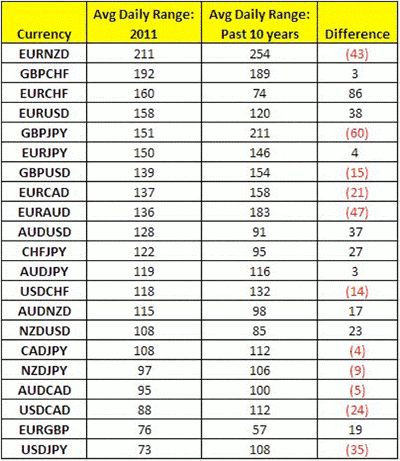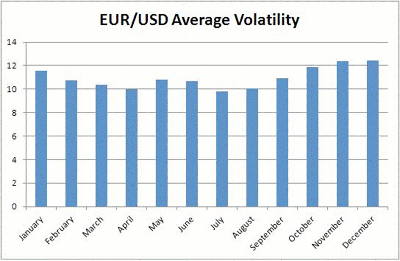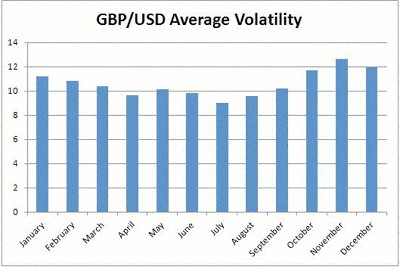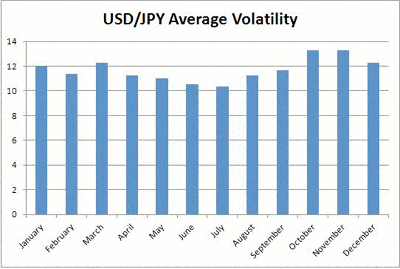This study of current and historical volatilities among major currency pairs reveals an interesting misconception about today’s markets and helps predict volatility levels for the rest of 2011.
The lack of US economic data early this week gives us an opportunity to discuss other less time-sensitive topics that are of interest to currency traders.
With the European sovereign debt crisis in full swing, currencies trading at significant highs and lows, and central banks jumping into the markets to prevent further appreciation, it is no wonder that most traders feel like volatility has increased significantly over the past year.
After examining the average daily trading range of all major currency pairs since the beginning of the year, however, the numbers show that the daily volatility in currencies is not up across the board.
The following table compares the average daily range of currencies since January with its average daily range over the past ten years. Yes, volatility has increased in some currency pairs, but it has also declined in others.
In general, volatility hasn’t changed all that much for most pairs compared to their ten-year averages. Yet, there are a few pairs worth noting. For example, USD/JPY is this year's least-volatile currency pair, having been around the middle of the pack in the past.
Much of this can be attributed to the yen floating around post-war highs and staying there as traders seek a safe haven in times of slowing economic growth. The upside is impacted by demand, but the downside is limited by fear of Bank of Japan intervention.
Another pair whose volatility has changed dramatically is EUR/CHF, which on a ten-year basis is the third-least-volatile currency pair.This year, however, with the franc soaring against the euro due to safe-haven flows and the Swiss National Bank jumping in to intervene and take the unprecedented move of pegging its currency against the euro, the average daily range of EUR/CHF is now the third highest.
The EUR/USD's average range has also increased, but USD/CHF and USD/CAD have become less volatile this year. Going forward, volatility could remain high as central banks gear up for more action before the end of the year.
The market is still waiting for the Federal Reserve to restart quantitative easing and for the European Central Bank (ECB) to lower interest rates. Merkel and Sarkozy's end-of-month plan to stabilize the region could also trigger some volatility depending upon whether their plan beats or misses expectations.
NEXT: Volatility Patterns for EUR/USD, GBP/USD, and USD/JPY
|pagebreak|The following charts of one-month average option volatilities in the three major currencies offer some additional clues:
On a seasonality basis, the last three months of the year tend to have the highest volatility.As the graphs indicate, trading tends to be more muted over the summer and picks up in September and October into November and December.
Traditionally, volatility increases around this time of year because it is the last opportunity for investors and funds to generate alpha before their books are closed at year end. Additionally, many international businesses repatriate their earnings in December for fiscal year end, which can cause more volatility.
We expect this historical trend to hold in 2011 because of the number of uncertainties in the market. Greece is still at the brink of default and does not know whether it will receive its last bailout payment.
Traders and investors are still waiting to see if the European Financial Stability Facility (EFSF) will be increased and if the ECB will lower interest rates. And, let’s not forget that the Federal Reserve needs to decide if they want to reinitiate quantitative easing before the end of the year.
There are a lot of moving parts in this global economy that could impact volatility from now to December, and for currency traders, this leaves the choice of reducing your exposure to accommodate wider stops or to focus on shorter-term trading to take advantage of the increase in volatility.
By Kathy Lien of KathyLien.com

























